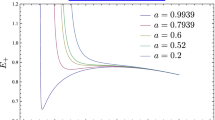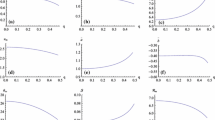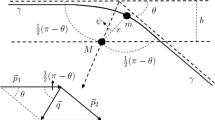Abstract
The null geodesics that describe photon orbits in the spacetime of a rotating electrically charged black hole (Kerr–Newman) are solved exactly including the contribution from the cosmological constant. We derive elegant closed form solutions for relativistic observables such as the deflection angle and frame dragging effect that a light ray experiences in the gravitational fields (i) of a Kerr–Newman black hole and (ii) of a Kerr–Newman–de Sitter black hole. We then solve the more involved problem of treating a Kerr–Newman black hole as a gravitational lens, i.e. a KN black hole along with a static source of light and a static observer both located far away but otherwise at arbitrary positions in space. For this model, we derive the analytic solutions of the lens equations in terms of Appell and Lauricella hypergeometric functions and the Weierstraßmodular form. The exact solutions derived for null, spherical polar and non-polar orbits, are applied for the calculation of frame dragging for the orbit of a photon around the galactic centre, assuming that the latter is a Kerr–Newman black hole. We also apply the exact solution for the deflection angle of an equatorial light ray in the gravitational field of a Kerr–Newman black hole for the calculation of bending of light from the gravitational field of the galactic centre for various values of the Kerr parameter, electric charge and impact factor. In addition, we derive expressions for the Maxwell tensor components for a zero-angular-momentum-observer (ZAMO) in the Kerr–Newman–de Sitter spacetime.















Similar content being viewed by others
Notes
By solving the Hamilton–Jacobi equation by the method of separation of variables.
Curved spacetime geometries surrounding non-spinning charged bodies or black holes.
Explicitly Eq. (27) reads: \(\tilde{\xi }=\wp (-\phi +\wp ^{-1}(\tilde{\xi }_0))\), where \(\tilde{\xi }_0\) is the initial value of \(\tilde{\xi }\).
We also mention the following integral identity in the definition of the real half-period \(\omega \): \(\omega =\int _{e_3}^{e_2}\frac{\mathrm{d}x}{\sqrt{4x^3-g_2^{\prime \prime }x-g_3^{\prime \prime }}}=\int _{e_1}^{+\infty }\frac{\mathrm{d}x}{\sqrt{4x^3-g_2^{\prime \prime }x-g_3^{\prime \prime }}}\), when all the branch points are real and the lattice rectangular [37]. A similar integral identity holds in the definition of \(\omega ^{\prime }\).
Equation (58) is easily proved by using the integral representation of Appell’s function \(F_1\) and performing the change of variables: \(u=1-v\) to the original variable of integration \(u\).
See Appendix 2 for the integral representation that the Appell–Lauricella hypergeometric function admits. We also have the correspondence \(\alpha _{\mu +1}=\alpha ,\alpha _{\mu +2}=\beta ,\alpha _{\mu -1}=r^{\prime }_{+}=\alpha _{\mu -2},\alpha _{\mu -3}=\gamma ,\alpha _{\mu } =\delta \).
In the usual units: \(r_{\pm }=\frac{GM_\mathrm{BH}}{c^2}\pm \sqrt{\left( \frac{GM_\mathrm{BH}}{c^2}\right) ^2-\left( \frac{Ge^2}{c^4}+a^2\right) }\).
In this regard, we also mention that the author in [30], under the assumption that the curved geometry surrounding the massive object in the Galactic Centre is a Reissner–Nordström (RN) spacetime, obtained an upper bound of \(e\lesssim 3.6\times 10^{27}\)C. This upper bound does not distinguish yet between a RN black hole scenario and a RN naked singularity scenario.
Such an analysis will be a subject of a future publication.
We also assume without loss of generality that \(\phi _O=0\).
In establishing (134) we used the fact that the sum of the second and third term on the right hand side of Eq. (132) can be written as: \(\int _{\xi _S}^{\xi _m}+(1-\sigma _S)\int _{\xi _0}^{\xi _S}\), where \((\xi _m,\xi _0)\) are extremal values of \(\xi \); thus, one can separate from it the expression \(\sigma _S\int _{\xi _S}^{\infty }\propto \sigma _S \wp ^{-1}(\xi )\).
References
Newman, E.T., Couch, E., Chinnapared, K., Exton, A., Prakash, A., Torrence, R.: Metric of a rotating, charged mass. J. Math. Phys. 6, 918 (1965)
Ohanian, H., Ruffini, R.: Gravitation and Spacetime. Norton, New York (1994)
Kerr, R.P.: Gravitational field of a spinning mass as an example of algebraically special metrics. Phys. Res. Lett. 11, 237 (1963)
Perlmutter, S., et al.: Astrophys. J. 517, 565 (1999)
Filippenko, A.V., et al.: Astron. J. 116, 1009
Kraniotis, G.V., Whitehouse, S.B.: General relativity, the cosmological constant and modular forms. Class. Quantum Gravit. 19, 5073–5100 (2002)
Kraniotis, G.V., Whitehouse, S.B.: Compact calculation of the perihelion precession of Mercury in general relativity the cosmological constant and Jacobi’s inversion problem. Class. Quantum Gravit. 20, 4817–4835 (2003)
Kraniotis, G.V.: Precise analytic treatment of Kerr and Kerr-(anti) de Sitter black holes as gravitational lenses. Class. Quantum Gravit. 28, 085021 (2011)
Hackmann, E., Lämmerzahl, C.: Geodesic equation in Schwarzschild-(anti-)de Sitter space–times: analytical solutions and applications. Phys. Rev. D 78, 024035 (2008)
Stuchlík, Z., Schee, J.: Comparison of general relativistic and pseudo-Newtonian description of Magellanic clouds motion in the field of Milky Way. Int. J. Mod. Phys. D 21, 1250031 (2012)
Stuchlík, Z., Schee, J.: Influence of the cosmological constant on the motion of Magellanic Clouds in the gravitational field of Milky Way. JCAP 9, 018 (2011)
Sultana, J.: Contribution of the cosmological constant to the bending of light in Kerr–de Sitter spacetime. Phys. Rev. D 88, 042003 (2013)
Stuchlík, Z., Bao, G., Østgaard, E., Hledík, S.: Kerr–Newman–de Sitter black holes with a restricted repulsive barrier of equatorial photon motion. Phys. Rev. D. 58, 084003 (1998)
Carter, B.: In: De Witt, C., De Witt, B.S. (eds.) Black Holes. Gordon and Breach, New York (1973)
Griffiths, J.B., Podolský, Jiří: Exact Spacetimes in Einstein’s General Relativity, Cambridge Monographs in Mathematical Physics. Cambirdge University Press, Cambirdge (2009)
Stuchlík, Z.: The motion of test particles in black-hole backgrounds with non-zero cosmological constant. Bull. Astron. Inst. Chechoslovakia 34, 129–149 (1983)
Bardeen, J.M., Press, W.H., Teukolsky, S.A.: Rotating black holes: locally nonrotating frames, energy extraction, and scalar synchrotron radiation. Astrophys. J. 178, 347–369 (1972)
Carter, B.: Global structure of the Kerr family of gravitational fields. Phys. Rev. 174, 1559–1571 (1968)
Kraniotis, G.V.: Precise relativistic orbits in Kerr and Kerr-(anti) de Sitter spacetimes. Class. Quantum Gravit. 21, 4743–4769 (2004)
Calvani, M., Turolla, R.: Complete description of photon trajectories in the Kerr–Newman space–time. J. Phys. A. Math. Gen. 14, 1931–1942 (1981)
Stuchlík, Z., Hledík, S.: Equatorial photon motion in the Kerr–Newman spacetimes with a non-zero cosmological constant. Class. Quantum Gravit. 17, 4541–4576 (2000)
Johnston, M., Ruffini, R.: Generalized Wilkins effect and selected orbits in a Kerr–Newman geometry. Phys. Rev. D. 10, 2324–2329 (1974)
Hackmann, E., Xu, H.: Charged particle motion in Kerr–Newmann spacetimes. Phys. Rev. D. 87, 124030 (2013)
Pugliese, D., Quevedo, H., Ruffini, R.: Equatorial circular orbits of neutral test particles in the Kerr–Newman spacetime. Phys. Rev. D 88, 024042 (2013)
Kraniotis, G.V.: Frame dragging and bending of light in Kerr and Kerr-(anti) de Sitter spacetimes. Class. Quantum Gravit. 22, 4391–4424 (2005)
Ghez, A.M., et al.: Measuring distance and properties of the Milky Way’s central supermassive black hole with stellar orbits. Astrophys. J. 689, 1044 (2008). ( arXiv:0808.2870)
Genzel, R., et al.: Rev. Mod. Phys. 82, 3121–3195 (2010)
Ray, S., Espinoza, A.L., Malheiro, M.: Electrically charged compact stars and formation of charged black holes. Phys. Rev. D. 68, 084004 (2003)
Mosquera Cuesta, H.J., Penna-Firme, A., Pérez-Lorenzana, A.: Charge asymmetry in the brane world and the formation of charged black holes. Phys. Rev. D 67, 087702 (2003)
Iorio, L.: Constraining the electric charges of some astronomical bodies in Reissner–Nordström spacetimes and generic \(r^{-2}-\)type power-law potentials from orbital motions. Gen Relativ. Gravit. 44, 1753–1767 (2012)
Kuc̆áková, H., Slaný, P., Stuchlík, Z.: Toroidal configurations of perfect fluid in the Reissner–Nordström-(anti-)de Sitter spacetimes. JCAP 01, 033 (2011)
Olivares, M., Saavedra, J., Leiva, C., Villanueva, J.R.: Motion of charged particles on the Reissner–Nordström–(anti-)de Sitter spacetime. Modern Phys. Lett. A 26, 2923–2950 (2011)
Lauricella, G.: Sulle funzioni ipergeometriche a più variabili. Rend. Circ. Mat. Palermo 7, 111–158 (1893)
Appell, P.: Sur les fonctions hypergéometriques de deux variables. J. Math. Pure Appl. 8, 173–216 (1882)
Stoghianidis, E., Tsoubelis, D.: Polar orbits in the Kerr space–time. Gen. Relativ. Gravit. 19, 1235–1249 (1987)
Whittaker, E.: A Treatise on the Analytical dynamics of Particles and Rigid bodies. Cambridge University Press, Cambridge (1947)
du Val, P.: Elliptic Functions and Elliptic Curves (London Mathematical Society). CUP, Cambridge (1973)
Genzel, R., et al.: Near infrared flares from accreting gas around the supermassive black hole at the Galactic centre. Nature 425, 934–7 (2003)
Aschenbach, B., Grosso, N., Porquet, D., Predehl, P.: X-ray flares reveal mass and angular momentum of the Galactic centre black hole. Astron. Astrophys. 417, 71–8 (2004). http://arxiv.org/abs/astro-ph/0401589astro-ph/0401589
Eisenhauer, F., et al.: Sinfoni in the galactic centre: young stars and infrared flares in the central light-month. Astrophys. J. 628, 246–259 (2005)
Kraniotis, G.V.: Periapsis and gravitomagnetic precessions of stellar orbits in Kerr and Kerr–de Sitter black hole spacetimes. Class. Quantum Gravit. 24, 1775–1808 (2007)
Meyer, L., et al.: The shortest-known-period star orbiting our Galaxy’s supermassive black hole. Science 338, 84 (2012)
Kraniotis, G. V.: Work in Progress
de Vries, A.: Class. Quantum Gravit. 17, 123–144 (2000)
Punsly, B.: High-energy gamma-ray emission from galactic Kerr–Newman black holes. I. The central engine. Astrophys. J. 498, 640–659 (1998)
Ruderman, R.A., Sutherland, P.G.: Astrophys. J. 196, 51 (1975)
Cherubini, C., Geralico, A., Rueda, J.A., Ruffini, R.: \(e^{-}-e^{+}\) pair creation by vacuum polarization around electromagnetic black holes. Phys. Rev. D. 79, 124002 (2009)
Greiner, W., Schramm, S.: Resource letter QED-1: the QED vacuum. Am. J. Phys. 76, 509–518 (2008)
MacKean, H., Moll, V.: Elliptic Curves. Cambridge University Press, Cambridge (1999)
Thorne, K., Price, R., Macdonald, D.: Black Holes: The Membrane Paradigm. Yale University Press, New Haven (1986)
Bic̆ak, J., Stuchlík, Z., Balek, V.: The motion of charged particles in the field of rotating charged black holes and naked singularities. Bull. Astron. Inst. Chechoslovakia 40, 65–92 (1989)
Acknowledgments
I thank my family for support, Zdenĕk Stuchlík, G. Leontaris and M. Stamatis for discussions. I am grateful to the referees for the careful reading of the manuscript and their very constructive comments and suggestions that helped improve the presentation of this work.
Author information
Authors and Affiliations
Corresponding author
Appendices
Appendix 1: The roots of the quartic in terms of Weierstraßfunctions
We are going to use the addition theorem for the Weierstraßelliptic function to express the roots of the quartic \(P_{4}(x)=x^{4}+ax^{2}+bx+c\in \mathbb {C} [x]\) in terms of the Weierstraßfunctions following [49]. We first write \(x\) for a point of the cover \(\mathbb {C}\) and \(\mathfrak {p}=(\mathbf{x},\mathbf{y})\) for the corresponding point of the cubic determined by \(\mathbf{x}=\wp (x)\) and \(\mathbf{y} ={\wp }^{\prime }(x)\). Then we study the intersections of the cubic \(\mathbf{y}^{2}=4\mathbf{x}^{3}-g_{2}\mathbf{x}-g_{3}\) and the line \(\mathbf{y}=a\mathbf{x}+b:\, \mathbf{x}_{1},\mathbf{x}_{2},\mathbf{x}_{3}\) are the roots of
so
and
We note that \(a\) is the slope of the line, so for distinct \(\mathbf{x}_{1},\mathbf{x}_{2},\mathbf{x}_{3}\) we have
Now
Thus
In the second equality of (145) we used the addition theorem \(x_1+x_2=-x_3\) in \(\mathbb {C}/\mathbb {L}\), \(\mathbb {L}\) the period lattice, and the fact that the Weierstraßfunction is even. For fixed \(x_{1},\) and variable \(x_{2},\) \(P_{4}(X)=0\) only if \(Y=0\). This occurs for \(x_{2}=-\frac{x_{1}}{2}\) to which may be added one of the three half-periods producing four roots of \(P_{4}(x)=0\) and these must be distinct, see Eqs. (86)–(89).
Appendix 2: Lauricella’s multivariable hypergeometric function \(F_D\)
In this Appendix 2, we define Lauricella’s 4th hypergeometric function of \(m\)-variables and its integral representation:
where
The Pochhammer symbol \(\boxed {\displaystyle (\alpha )_m=(\alpha ,m)}\) is defined by
With the notations \(\mathbf {z}^\mathbf{n}:=z_1^{n_1}\cdots z_m^{n_m},(\varvec{\beta })_{\mathbf {n}}:=(\beta _1)_{n_1}\cdots (\beta _m)_{n_m}, \mathbf {n!}=n_1!\cdots n_m!, |\mathbf {n}|:=~n_1+\cdots +n_m\) for \(m\)-tuples of numbers in (147) and of non-negative integers \(\mathbf {n}=(n_1,\ldots n_m)\) the Lauricella series \(F_D\) in compact form is
The series admits the following integral representation:
which is valid for \(\boxed {\displaystyle \mathrm{Re}(\alpha )>0,\;\mathrm{Re}(\gamma -\alpha )>0.}\). It converges absolutely inside the m-dimensional cuboid:
For \(m=2\,F_D\) in the notation of Appell becomes the two variable hypergeometric function \(F_1(\alpha ,\beta ,\beta ^{\prime },\gamma ,x,y)\) with integral representation:
Appendix 3: Calculation of the Maxwell tensor components in the ZAMO frame for the KNdS spacetime
The ZAMO basis vectors are determined by the transformation
where the angular velocity \(\Omega \) is given in the KNdS case by the expression:
and the quantity \(g_{tt}g_{\phi \phi }-g^2_{\phi t}=\frac{-c^2 {\varDelta }_r^{KN}{\varDelta }_{\theta }\sin ^2\theta }{{\varXi }^4}\). In addition, we compute for the lapse function \(\alpha _{ZAMO}\):
Equation (158), reduces correctly, assuming \({\varLambda }=0\), to the lapse function derived in [50].
Now our analytic calculation for the electric (\(\varvec{E}\)) and magnetic fields (\(\varvec{B}\)) in the presence of the cosmological constant \({\varLambda }\) in the ZAMO frame yields:
Also it holds:
To the best of our knowledge Eqs. (159)–(162) represent the first calculation of the Maxwell tensor components in the ZAMO frame for the case of the Kerr–Newman–de Sitter spacetime. Our solutions for the electric and magnetic fields, for zero cosmological constant, reduce correctly to the corresponding expressions for the Kerr–Newman spacetime and LNRF observers derived in [51].
Rights and permissions
About this article
Cite this article
Kraniotis, G.V. Gravitational lensing and frame dragging of light in the Kerr–Newman and the Kerr–Newman (anti) de Sitter black hole spacetimes. Gen Relativ Gravit 46, 1818 (2014). https://doi.org/10.1007/s10714-014-1818-8
Received:
Accepted:
Published:
DOI: https://doi.org/10.1007/s10714-014-1818-8
Keywords
- Null geodesics
- Exact solutions
- Kerr-Newman (anti) de Sitter black hole
- Gravitational lensing and frame dragging
- Weierstraßelliptic functions
- Appell-Lauricella hypergeometric functions




